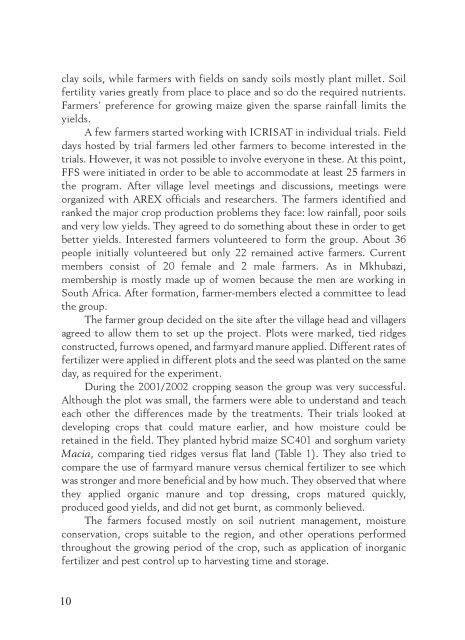Integrated Soil Water and Nutrient Management and Dry ... - Icrisat
Integrated Soil Water and Nutrient Management and Dry ... - Icrisat
Integrated Soil Water and Nutrient Management and Dry ... - Icrisat
You also want an ePaper? Increase the reach of your titles
YUMPU automatically turns print PDFs into web optimized ePapers that Google loves.
clay soils, while farmers with fields on s<strong>and</strong>y soils mostly plant millet. <strong>Soil</strong><br />
fertility varies greatly from place to place <strong>and</strong> so do the required nutrients.<br />
Farmers’ preference for growing maize given the sparse rainfall limits the<br />
yields.<br />
A few farmers started working with ICRISAT in individual trials. Field<br />
days hosted by trial farmers led other farmers to become interested in the<br />
trials. However, it was not possible to involve everyone in these. At this point,<br />
FFS were initiated in order to be able to accommodate at least 25 farmers in<br />
the program. After village level meetings <strong>and</strong> discussions, meetings were<br />
organized with AREX officials <strong>and</strong> researchers. The farmers identified <strong>and</strong><br />
ranked the major crop production problems they face: low rainfall, poor soils<br />
<strong>and</strong> very low yields. They agreed to do something about these in order to get<br />
better yields. Interested farmers volunteered to form the group. About 36<br />
people initially volunteered but only 22 remained active farmers. Current<br />
members consist of 20 female <strong>and</strong> 2 male farmers. As in Mkhubazi,<br />
membership is mostly made up of women because the men are working in<br />
South Africa. After formation, farmer-members elected a committee to lead<br />
the group.<br />
The farmer group decided on the site after the village head <strong>and</strong> villagers<br />
agreed to allow them to set up the project. Plots were marked, tied ridges<br />
constructed, furrows opened, <strong>and</strong> farmyard manure applied. Different rates of<br />
fertilizer were applied in different plots <strong>and</strong> the seed was planted on the same<br />
day, as required for the experiment.<br />
During the 2001/2002 cropping season the group was very successful.<br />
Although the plot was small, the farmers were able to underst<strong>and</strong> <strong>and</strong> teach<br />
each other the differences made by the treatments. Their trials looked at<br />
developing crops that could mature earlier, <strong>and</strong> how moisture could be<br />
retained in the field. They planted hybrid maize SC401 <strong>and</strong> sorghum variety<br />
Macia, comparing tied ridges versus flat l<strong>and</strong> (Table 1). They also tried to<br />
compare the use of farmyard manure versus chemical fertilizer to see which<br />
was stronger <strong>and</strong> more beneficial <strong>and</strong> by how much. They observed that where<br />
they applied organic manure <strong>and</strong> top dressing, crops matured quickly,<br />
produced good yields, <strong>and</strong> did not get burnt, as commonly believed.<br />
The farmers focused mostly on soil nutrient management, moisture<br />
conservation, crops suitable to the region, <strong>and</strong> other operations performed<br />
throughout the growing period of the crop, such as application of inorganic<br />
fertilizer <strong>and</strong> pest control up to harvesting time <strong>and</strong> storage.<br />
10

















